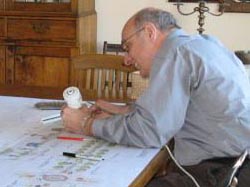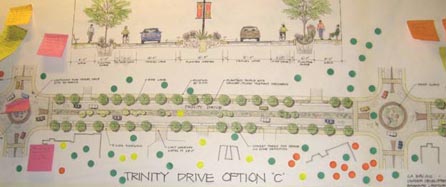

Click here to see a map of Trinity Drive.


|
Completing the street means striking a balance between the need to move traffic through Los Alamos along Trinity Drive, and the need for a lively, vibrant downtown. The "as as" condition of the street is not an option, even if that were desirable (and the vast majority of those we've sampled say it's not). Trinity Drive is substandard in many respects, ranging from sidewalk conditions to noncompliance with ADA requirements; by law, Trinity needs to be brought up to federal standards. Over the last decade, new housing has been developed on the south side of Trinity west of Oppenheimer, where sidewalks are narrow and there are no safe pedestrian crossings. Significant new development will occur on Trinity, most notably Boyer's Trinity Place project. These developments create new transportation and access requirements that must be addressed. In addition, the State Department of Transportation plans a major reconstruction of State Road 502, which includes Trinity up to Knecht Street. It is important for the County to be proactive with respect to these changes, and develop consensus designs that serve the needs of all our citizens. There are many issues to be addressed in any proposed modification of Trinity—The needs of drivers, pedestrians, cyclists, transit users, and people with disabilities; existing rights-of-way and County development codes; new and existing development; State and Federal standards and guidelines. To examine all these issues and develop possible design alternatives, the Downtown Streets Standards Committee was formed in September 2008 by Rick Bohn, Los Alamos County's Community Development Department director. It includes representatives from other County departments (e.g., Public Works), the Transportation Board, Los Alamos Commerce and Development Corporation (LACDC, representing the business community), LA Walks, and the New Mexico State Department of Transportation. The committee's charter is to look at standards for all downtown streets, but because if its importance the initial focus is on Trinity Drive. Design alternatives generated by the committee are on the web, courtesy of LACDC, for public comment. Click here to see them. Alternatives were also presented to the Transportation Board, and presented to the public for comment at a County "Complete Our Streets" open house at the Community Center on January 22, 2009. For more information on the Downtown Streets Standards Committee, contact Paul Belson, paul.belson@lacnm.us. As a follow-on to the "Complete Our Streets" open house, LA Walks and Los Aalamos County sponsored a workshop on Thursday, March 5th, at Fuller Lodge. (LA Walks' contribution was funded through a grant from the State DOT Walkability Advocacy Group Program.) This was the flyer advertising the workshop. LA Walks would like to thank the many County staff members who contributed, particularly Martha Perkins and Paul Belson. The workshop was facilitated by Vicki Dugger, former director of the Oregon Downtown Development Association (shown below, discussing feedback from the public on one of the alternative designs) and Richard Zita, Principal of Bramare Landscape Architecture (shown on the left above, preparing a poster of one of the design alternatives). It included presentations by Dugger, Zita, Wendy Swanson of LA Walks, Rick Bohn, and Kyle Zimmerman (Public Works Department director). More than 90 people attended the meeting, voted on alternatives, and commented on features of the designs. In the picture below, the "votes" are colored dots: red expressing dislike, green expressing approval, and yellow meaning more information was needed to decide. The Post-it notes stuck to the poster are public comments, which were collected and will be analyzed by the Downtown Streets Standards Committee. Here is a story on the workshop which appeared in the Los ALamos Monitor the following day.
Please visit this page again, for updates on the ongoing process of "completing the street" on Trinity Drive. For more information on complete streets—designed and operated to enable safe access for all users—see Complete The Streets, the web site of the National Complete Streets Coalition, which has news, detailed information, and resources for making streets safe and usable for everyone. A similar Complete the streets initiative from America Bikes focuses on safer bicycling and walking. |
| Home | Pedestrian survey | Visions/projects | Walkability Links |